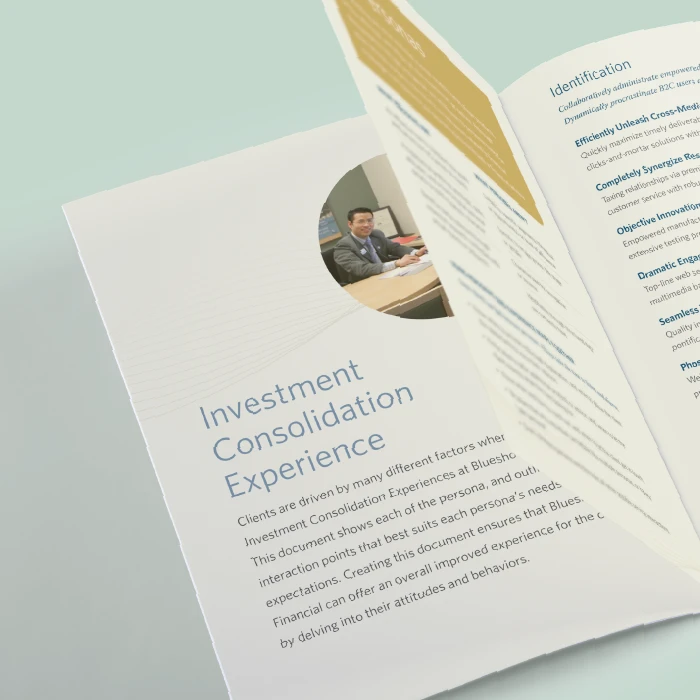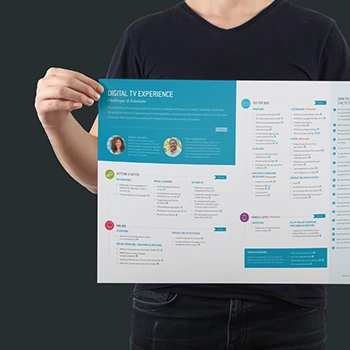What exactly is customer research and why is it essential?
Customer research provides deep insights to inform better customer experiences by understanding how products and services are truly being experienced. Through our Experience Thinking framework, we examine customer interactions across brand, content, product, and service touchpoints to reveal behavioral patterns, motivations, and pain points that drive decision-making and loyalty.
Tip: Focus on understanding actual customer behavior rather than just collecting demographic information or stated preferences.
How does customer research differ from market research?
Customer research focuses on understanding how people experience your organization across the entire relationship lifecycle, while market research typically examines broader market trends and competitive landscapes. Our approach uses behavioral psychology and ethnographic methods to understand the nuances of how customers interact with your specific brand, products, and services.
Tip: Combine customer research insights with market data to understand both individual behavior and broader market context.
What's the relationship between qualitative and quantitative customer research?
Qualitative methods provide deep insights answering 'why' questions through interviews, observations, and contextual inquiry. Quantitative methods answer 'where' and 'how often' questions through surveys, analytics, and A/B testing. Both can reveal attitudinal information and behavioral data, though sometimes these dimensions contrast when people say one thing but do another.
Tip: Use quantitative data to validate qualitative patterns rather than treating them as separate research streams.
How does Experience Thinking enhance customer research?
Experience Thinking examines customer interactions across four connected quadrants - brand experience, content experience, product experience, and service experience. This holistic approach reveals how customers experience your organization as an integrated system rather than isolated touchpoints. It helps identify where experiences connect well and where disconnects create friction in the customer journey.
Tip: Map research findings across all four Experience Thinking quadrants to identify systemic issues rather than just point solutions.
What types of customer insights does research typically reveal?
Research reveals behavioral patterns, decision-making processes, emotional triggers, contextual factors, unmet needs, and experience pain points. We uncover how customers discover, evaluate, purchase, use, and advocate for products and services. Our anthropological approach also reveals cultural and psychological factors that traditional research methods might miss.
Tip: Look for behavioral patterns and emotional drivers rather than just functional requirements when analyzing customer insights.
How do you ensure customer research findings are actionable?
We design research specifically to answer business questions and support strategic decisions. Our methodology connects customer insights directly to design opportunities, feature prioritization, and experience improvements. Through Experience Thinking, insights translate into specific actions across brand strategy, content development, product enhancement, and service design.
Tip: Define specific business decisions the research should inform before beginning data collection rather than conducting exploratory research without clear objectives.
What's the difference between customer, user, and client research?
Customer research focuses on the buying phase when prospects evaluate value and make purchase decisions. User research examines how people interact with products and services to accomplish tasks. Client research investigates long-term relationships and ongoing service interactions. The Experience Thinking framework recognizes that people move through these roles across the lifecycle, requiring different research approaches.
Tip: Plan research that captures customer evolution across the entire relationship lifecycle rather than focusing on just one phase.
What customer research methods do you use?
We employ ethnographic interviews, contextual inquiry, participant observation, focus groups, surveys, analytics analysis, A/B testing, and journey mapping. Our anthropological background enables us to understand cultural and behavioral factors through methods like job shadowing and apprenticeship approaches. Method selection depends on research objectives, timeline, and the type of insights needed.
Tip: Choose research methods based on the specific business questions you need answered rather than defaulting to familiar techniques.
When do you use qualitative versus quantitative research methods?
Qualitative methods work best for discovery, understanding motivations, and exploring new concepts. Quantitative methods excel at measuring patterns, validating hypotheses, and extrapolating findings to larger populations. We often combine both approaches - qualitative research to understand why customers behave certain ways, then quantitative validation to measure scale and impact.
Tip: Start with qualitative research to understand customer behavior, then use quantitative methods to validate and scale insights.
How do you conduct customer interviews effectively?
We use both exploratory and confirmatory interview approaches depending on research goals. Exploratory interviews are unstructured, allowing natural conversation that reveals unexpected insights. Confirmatory interviews follow consistent themes for comparison across participants. Sessions typically last 30-60 minutes and focus on understanding behavioral patterns rather than just opinions.
Tip: Prepare interview guides that explore both rational decision-making factors and emotional influences on customer behavior.
What's contextual inquiry and when is it most valuable?
Contextual inquiry combines observation with in-context interviews using a master/apprentice model where researchers observe customers in their natural environment. This method reveals communication flows, processes, tools, physical and cognitive requirements, and cultural factors. It's particularly valuable when redesigning existing workflows or understanding complex customer processes.
Tip: Use contextual inquiry when you need to understand how customers actually behave rather than what they say they do.
How do you design effective customer surveys?
Surveys gather information from large numbers of customers efficiently and can be analyzed statistically with sufficient sample sizes. We use closed questions for confirmatory research and more open questions for exploratory studies. Surveys work best when paired with qualitative methods since they lack the ability to probe deeper into responses or understand the 'why' behind behaviors.
Tip: Design surveys to validate specific hypotheses from qualitative research rather than using them as standalone research tools.
What role does behavioral observation play in customer research?
Behavioral observation reveals what customers actually do versus what they say they do, often uncovering significant differences between stated preferences and actual behavior. We observe customers in natural contexts to understand real usage patterns, workarounds, and pain points. This method provides unbiased insights into customer behavior patterns.
Tip: Combine behavioral observation with interviews to understand both what customers do and why they do it.
How do you use analytics data in customer research?
Analytics capture quantitative data about actual customer behavior on websites and applications. We identify proper metrics that align with customer goals and business objectives, then analyze patterns to understand where experience issues occur. Analytics help verify qualitative research findings and identify areas warranting deeper investigation through other methods.
Tip: Define meaningful customer success metrics before analyzing analytics data rather than just reporting on available data points.
How do you plan a customer research project?
Planning begins with understanding business objectives, customer touchpoints, and specific decisions the research should inform. We align stakeholders on research goals, design appropriate methodologies, plan participant recruitment, and establish timelines. Through Experience Thinking, we ensure research covers the complete customer experience across brand, content, product, and service interactions.
Tip: Start research planning by identifying specific business decisions the insights should inform rather than general customer understanding goals.
How do you determine the right research methodology for our needs?
Methodology selection depends on research objectives, customer complexity, timeline constraints, and the type of insights needed. Exploratory research uses open-ended qualitative methods, while validation research employs structured quantitative approaches. We consider customer lifecycle phases, touchpoint complexity, and behavioral variance when designing research approaches.
Tip: Match research methodology to your specific business context and decision-making needs rather than using standard research packages.
How many customers should participate in research studies?
Participant numbers depend on research methodology, customer complexity, and objectives. For qualitative research, saturation typically occurs around 20 participants, though 10 can suffice for simpler contexts. We recommend 3 participants per customer segment as a starting point. For quantitative studies, sample sizes need statistical significance - typically 20+ for performance metrics but potentially 50+ for reliable extrapolation.
Tip: Focus on recruiting the right participants rather than just increasing numbers to ensure findings represent your actual customer base.
How long does customer research typically take?
Research timelines vary based on scope, methodology, and participant availability. Basic customer research projects take 6-10 weeks including planning, recruitment, data collection, analysis, and validation. Complex studies involving multiple customer segments or international markets may require 12-16 weeks. We provide regular progress updates and preliminary findings throughout the process.
Tip: Build flexibility into research timelines for participant recruitment challenges rather than compressing critical research phases.
What's your approach to customer research recruitment?
Recruitment strategies combine existing customer databases, professional recruitment services, and targeted outreach through appropriate channels. We focus on behavioral characteristics, experience with your category, and contextual factors rather than just demographics. Screening ensures participants represent authentic customer perspectives and can contribute meaningful insights.
Tip: Define recruitment criteria based on customer behaviors and contexts relevant to your business rather than broad demographic categories.
How do you adapt research methods for different industries?
Industry adaptation requires understanding sector-specific customer behaviors, regulatory constraints, and business contexts. We modify research approaches to respect industry protocols while maintaining insight quality. Our experience across technology, energy, healthcare, and financial services provides perspective on industry-specific customer research challenges and opportunities.
Tip: Work with researchers who understand your industry context rather than applying generic research methods to specialized business environments.
How do you ensure research captures diverse customer perspectives?
Diversity planning includes representation across behavioral segments, geographic regions, accessibility needs, and demographic categories relevant to your business. We use inclusive research methods and actively seek perspectives that might be overlooked by traditional approaches. Our goal is ensuring research findings represent the full spectrum of your customer base.
Tip: Define diversity criteria based on factors that actually impact customer behavior rather than generic demographic representation requirements.
How do you analyze customer research data to generate insights?
Analysis involves systematic pattern identification across qualitative and quantitative data using affinity mapping, behavioral clustering, and statistical techniques. Our anthropological approach reveals cultural and contextual factors that traditional analysis might miss. We synthesize findings into actionable insights that directly inform business strategy and experience design decisions.
Tip: Look for behavioral patterns and motivational themes rather than just surface-level preferences when analyzing customer data.
What types of customer insights do you typically uncover?
Research reveals unmet needs, behavioral patterns, decision-making processes, emotional triggers, pain points, and experience expectations. Through Experience Thinking, we understand how customers experience your organization holistically across brand interactions, content consumption, product usage, and service touchpoints. Insights often challenge existing assumptions about customer motivations.
Tip: Prepare for research findings that contradict internal assumptions about customer behavior rather than expecting confirmation of existing beliefs.
How do you identify customer experience pain points and opportunities?
Pain point identification combines direct customer feedback with behavioral observation to understand where experiences break down. We examine friction across the entire customer lifecycle using Experience Thinking to identify disconnects between brand promises, content delivery, product performance, and service experiences. Opportunities emerge where customer needs exceed current capabilities.
Tip: Investigate the underlying causes of customer pain points rather than just addressing surface-level symptoms.
How do you validate customer research findings?
Validation includes triangulation across multiple data sources, stakeholder feedback sessions, additional customer touchpoints, and testing insights against actual customer behavior. We compare findings with existing customer data, conduct follow-up research, and validate predictions through real-world customer interactions to ensure insights reflect genuine customer reality.
Tip: Build validation checkpoints throughout the research process rather than treating initial findings as final insights.
What competitive insights does customer research reveal?
Customer research reveals how your audience evaluates alternatives, competitive perceptions, decision criteria, and satisfaction gaps across the market. We understand where competitors succeed or fail in addressing customer needs, creating opportunities for strategic differentiation. Research shows competitive positioning through actual customer experience rather than feature comparisons.
Tip: Analyze competitive landscape through your specific customer perspective rather than generic market analysis approaches.
How do you identify emerging customer needs and trends?
Trend identification combines current behavior analysis with forward-looking research methods including scenario planning, early adopter interviews, and prototype testing. We examine customer workarounds, aspirations, and unmet needs that suggest future opportunities. Our anthropological approach reveals cultural shifts that impact customer expectations.
Tip: Research customer problems and aspirations rather than just reactions to current solutions when identifying emerging opportunities.
How do you synthesize research insights into strategic recommendations?
Synthesis connects customer insights to specific business actions across strategy, design, and implementation. We translate behavioral findings into actionable recommendations for brand positioning, content strategy, product development, and service improvements. Through Experience Thinking, recommendations address the complete customer experience ecosystem rather than isolated improvements.
Tip: Connect research insights directly to business decisions and strategic priorities rather than presenting findings without clear application guidance.
How does customer research inform business strategy?
Research provides evidence-based foundation for strategic decisions including market positioning, value proposition development, and customer experience strategy. Customer insights reveal opportunities for differentiation, growth, and operational improvement. Through Experience Thinking, research ensures strategy addresses the complete customer relationship across all touchpoints and lifecycle phases.
Tip: Use customer research to challenge and validate strategic assumptions rather than just supporting existing business plans.
How do customer insights guide product development decisions?
Customer research reveals usage contexts, feature priorities, design requirements, and user goals that guide product development. Insights help resolve development debates through customer perspective and ensure products address real needs rather than internal assumptions. Research validates product concepts before significant investment and identifies improvement opportunities for existing products.
Tip: Integrate customer research into product planning cycles rather than treating it as a one-time validation exercise.
How does customer research support marketing and communications strategy?
Research reveals customer communication preferences, messaging resonance, channel behaviors, and brand perceptions that inform marketing strategy. Through Experience Thinking, customer insights ensure marketing messages align with actual brand experience and service delivery. Research guides campaign development, channel selection, and content creation for authentic customer connections.
Tip: Use customer research to understand emotional and rational factors that influence decision-making rather than just demographic targeting.
How do customer insights improve service design and delivery?
Service research reveals interaction preferences, support needs, communication styles, and relationship expectations that guide service design. We examine the complete service journey using Experience Thinking to ensure service experiences align with brand promises and product experiences. Research guides staff training, process optimization, and touchpoint improvement.
Tip: Research both customer-facing service elements and behind-the-scenes processes that impact customer experience quality.
How does customer research support digital transformation initiatives?
Digital transformation research examines how customers adapt to technology changes, preferred digital interaction patterns, and support needs during transitions. We investigate both current behaviors and future readiness to guide transformation strategy. Through Experience Thinking, research ensures digital initiatives enhance rather than disrupt positive customer experiences.
Tip: Research customer change readiness and technology comfort levels rather than just digital preferences when planning transformation initiatives.
How do customer insights inform pricing and value proposition strategy?
Research reveals how customers perceive value, evaluate pricing, and make cost-benefit decisions. We understand price sensitivity factors, value drivers, and competitive price perceptions that inform pricing strategy. Customer insights show what aspects of your offering customers value most, guiding value proposition development and pricing communication.
Tip: Research customer value perception rather than just price sensitivity to understand optimal pricing and value proposition strategies.
How does customer research support organizational change initiatives?
Customer research provides external perspective that motivates internal change by showing gaps between customer expectations and current delivery. Insights create shared understanding across departments and build support for customer-centric improvements. Research helps organizations prioritize change initiatives based on customer impact rather than internal preferences.
Tip: Use customer research findings to build internal coalition for change rather than just identifying improvement opportunities.
What deliverables do we receive from customer research projects?
Deliverables include research findings reports, customer insight summaries, strategic recommendations, implementation roadmaps, and presentation materials for stakeholder communication. We provide both detailed analysis and executive summaries tailored to different organizational audiences. All deliverables focus on actionable insights rather than just data presentation.
Tip: Specify deliverable formats that match your organization's existing workflow and decision-making processes.
How do you present customer research findings to different stakeholders?
Presentations are customized for audience interests - executives receive strategic insights and business implications, while practitioners get detailed behavioral findings and design guidance. We use storytelling techniques that make customer insights memorable and actionable. Presentations include opportunities for stakeholders to explore application to their specific challenges.
Tip: Focus presentations on business implications and strategic actions rather than just research methodology and data details.
What implementation guidance do you provide with research findings?
Implementation guidance includes specific recommendations for using insights in decision-making, process integration suggestions, and strategic roadmaps. We help organizations translate customer research into actionable business strategies across marketing, product development, service improvement, and organizational development. Guidance is customized to organizational context and capabilities.
Tip: Plan implementation support that addresses your organization's specific adoption challenges rather than generic research application advice.
How do you help organizations integrate customer insights into daily operations?
Integration requires embedding customer insights into decision-making workflows, planning processes, and performance measurement systems. We help organizations adapt existing processes to include customer perspective rather than creating separate research functions. Success depends on making customer insights accessible and relevant to daily business decisions.
Tip: Integrate customer insights into existing decision points and workflows rather than creating separate research processes that operate in isolation.
What training do you provide for using customer research effectively?
Training includes insight interpretation workshops, application exercises, and integration planning sessions tailored to different organizational roles. We help departments understand how to reference customer insights during decision-making and avoid common research misuse patterns. Training ensures research becomes a decision-making tool rather than just informational documentation.
Tip: Focus training on practical application scenarios specific to each department's daily decisions rather than general research awareness.
How do you measure the business impact of customer research?
Impact measurement includes tracking decision-making improvements, customer satisfaction changes, business performance metrics, and organizational alignment indicators. We establish baseline measurements before research implementation and monitor changes in customer-centric decision-making. Through Experience Thinking, we measure impact across all customer touchpoints rather than isolated metrics.
Tip: Define specific behavioral and business changes you expect from customer research rather than just measuring research activity or awareness.
What ongoing support do you provide after research delivery?
Ongoing support includes validation studies, application coaching, insight updates, and strategic consultation as business needs evolve. We help organizations maximize research value through continued collaboration and methodology refinement. Support ensures customer insights remain accurate and useful as behaviors and business contexts change.
Tip: Plan ongoing research validation and updates rather than treating initial studies as complete solutions to customer understanding.
How do you research B2B customer experiences?
B2B research requires understanding both individual motivations and organizational contexts that influence decision-making. We examine role-based behaviors, company constraints, procurement processes, and stakeholder dynamics. Through Experience Thinking, B2B research maps complex organizational touchpoints and extended decision cycles across multiple personas and departments.
Tip: Include organizational context and multi-stakeholder decision processes in B2B customer research rather than focusing solely on individual behaviors.
How do you conduct customer research for digital products and services?
Digital customer research examines online behaviors, device usage patterns, multi-channel interactions, and digital experience expectations. We investigate how customers navigate digital touchpoints, consume digital content, and integrate digital tools into their workflows. Research reveals opportunities for digital experience optimization and innovation.
Tip: Research actual digital usage contexts and multi-device behaviors rather than just stated preferences about digital experiences.
How do you research customer experiences for subscription or SaaS models?
Subscription research examines adoption patterns, usage evolution, value realization, and retention factors across extended customer relationships. We investigate how customer needs change through subscription lifecycles and what drives continued engagement versus churn. Research reveals opportunities for improving customer success and reducing churn.
Tip: Research subscription customer behavior across the entire relationship lifecycle rather than just initial adoption or cancellation factors.
How do you adapt customer research for regulated industries?
Regulated industry research requires understanding compliance constraints, professional protocols, and specialized decision-making processes while maintaining research quality. We adapt methods to respect industry requirements and professional contexts. Research examines both individual customer needs and regulatory requirements that influence customer behavior.
Tip: Understand industry regulations and professional protocols before designing customer research rather than assuming standard methods work in regulated contexts.
How do you research customer experiences across multiple markets or regions?
Multi-market research requires understanding cultural contexts, local market conditions, and behavioral variations across geographic regions. We adapt research methods to respect cultural differences while maintaining consistency in insight quality. Through Experience Thinking, we examine how cultural factors influence customer expectations across all experience touchpoints.
Tip: Partner with local research professionals who understand cultural nuances rather than applying standardized methods across all markets.
How do you handle sensitive topics or private information in customer research?
Sensitive research requires careful protocol design including privacy protection, informed consent, and ethical data handling throughout the process. We create safe spaces for customers to share honest perspectives while protecting their privacy and personal information. Research design ensures compliance with privacy regulations while maintaining insight depth.
Tip: Establish clear privacy and ethical guidelines before beginning customer research rather than addressing concerns reactively during data collection.
How do you research customer experiences for emerging technologies?
Emerging technology research examines customer adoption patterns, technology comfort levels, and integration preferences for new tools or platforms. We investigate how emerging technologies might fit into existing customer workflows and what barriers or opportunities exist for adoption. Research guides technology integration strategies based on actual customer readiness.
Tip: Research customer problems and contexts rather than technology features when evaluating emerging technology adoption opportunities.
How do you conduct longitudinal customer research studies?
Longitudinal research tracks customer behavior changes over time to understand experience evolution, lifecycle progression, and relationship development patterns. We follow customers through multiple touchpoints and lifecycle phases to understand how experiences change and what drives long-term satisfaction. This approach reveals insights unavailable from snapshot studies.
Tip: Plan longitudinal research to track specific behavioral changes rather than general satisfaction trends over time.
What's your approach to ethnographic customer research?
Ethnographic research involves deep immersion in customer environments to understand cultural contexts, social influences, and natural behaviors. Our anthropological background enables us to observe customer behavior in natural settings and understand cultural factors that influence decision-making. This approach reveals insights that traditional research methods often miss.
Tip: Use ethnographic methods when you need to understand customer behavior in natural contexts rather than artificial research environments.
How do you research customer emotions and psychological factors?
Emotional research combines behavioral observation with psychological techniques to understand emotional triggers, stress factors, and satisfaction drivers. We examine how emotions influence customer decision-making and experience perceptions. Through Experience Thinking, emotional research reveals how feelings connect across brand, content, product, and service interactions.
Tip: Research both emotional and rational factors that influence customer behavior rather than focusing solely on functional requirements.
How do you conduct customer research for innovation and new concept development?
Innovation research examines latent needs, emerging behaviors, and unmet opportunities rather than existing solution preferences. We use forward-looking methods including scenario planning, concept testing, and early adopter analysis. Through Experience Thinking, innovation research ensures new concepts integrate meaningfully with existing customer experiences.
Tip: Research customer problems and aspirations rather than just reactions to proposed solutions when developing innovative concepts.
What's your approach to participatory customer research?
Participatory research involves customers as co-researchers and co-designers rather than just research subjects. We facilitate workshops, design sessions, and collaborative exercises that leverage customer expertise and creativity. This approach creates shared ownership of solutions and reveals insights that traditional research-subject relationships cannot access.
Tip: Use participatory methods when you need customer buy-in for solutions rather than just understanding current behaviors.
How do you research customer experience across the complete lifecycle?
Lifecycle research maps customer experiences from initial awareness through advocacy, examining how needs, behaviors, and expectations evolve. Using Experience Thinking, we understand how customers move between customer, user, and client roles, requiring different experience strategies. This approach reveals opportunities for lifecycle optimization and relationship deepening.
Tip: Map customer research across the entire relationship lifecycle rather than focusing on single phases like acquisition or usage.
How does AI impact customer research methodology and insights?
AI enhances customer research through pattern identification in large datasets, automated transcription and initial analysis, and hypothesis generation from behavioral data. However, human expertise remains essential for understanding cultural context, emotional nuance, and strategic implications. We use AI to augment research capabilities while maintaining human judgment for insight interpretation and strategic application.
Tip: Use AI to enhance research efficiency and pattern recognition while preserving human expertise for understanding customer motivations and cultural context.
How do you help organizations become more customer-centric through research?
Customer-centric transformation requires embedding customer insights into organizational culture, decision-making processes, and performance measurement systems. We provide research that creates shared customer understanding across departments and establishes customer perspective as a key decision factor. Through Experience Thinking, transformation addresses the complete customer experience ecosystem.
Tip: Use customer research to create cultural change by making customer insights relevant to every department's daily decisions.
What role does customer research play in competitive differentiation?
Research reveals opportunities for distinctive positioning by understanding where competitors succeed or fail in addressing customer needs. We identify unmet needs, experience gaps, and preference patterns that suggest differentiation opportunities. Customer insights guide strategic positioning that resonates with specific segments while establishing competitive advantage.
Tip: Focus differentiation research on understanding customer problems that competitors haven't solved rather than just feature comparisons.
How does customer research support customer retention and loyalty strategies?
Retention research examines relationship satisfaction factors, service quality perceptions, and loyalty drivers across the customer lifecycle. Through Experience Thinking, we understand how experiences across brand, content, product, and service touchpoints contribute to customer loyalty. Research reveals specific improvements that strengthen customer relationships and reduce churn.
Tip: Research both satisfaction drivers and dissatisfaction triggers to understand the complete range of factors affecting customer retention.
How do customer insights inform customer acquisition strategies?
Acquisition research reveals how prospects discover, evaluate, and choose solutions in your category. We understand decision-making processes, evaluation criteria, information sources, and conversion barriers that inform acquisition strategy. Research guides marketing approaches, sales processes, and onboarding experiences that convert prospects into customers.
Tip: Research the complete customer acquisition journey rather than just final purchase decisions to identify optimization opportunities.
How does customer research support expansion into new markets?
Market expansion research examines customer behaviors, needs, and expectations in target markets to guide entry strategy. We investigate cultural differences, competitive landscapes, and local customer preferences that impact market success. Through Experience Thinking, expansion research ensures your complete experience translates appropriately to new market contexts.
Tip: Research local customer behaviors and cultural contexts rather than assuming existing customer insights apply to new markets.
How do you help organizations scale customer research capabilities?
Scaling requires developing internal research capabilities, establishing research operations, and creating systematic approaches to customer insight generation. We provide training, methodology development, and organizational design guidance that enables sustainable customer research capabilities. Scaling ensures ongoing customer understanding rather than project-based research.
Tip: Build internal customer research capabilities gradually rather than trying to implement advanced research programs immediately.
What's the long-term value of investing in customer research capabilities?
Long-term research investment creates sustainable competitive advantage through deep customer understanding, faster innovation cycles, reduced development risk, and stronger customer relationships. Organizations with strong research capabilities make better strategic decisions, develop more successful products, and maintain higher customer satisfaction. Research becomes a core organizational capability.
Tip: View customer research as a strategic capability investment rather than just a project expense to maximize long-term organizational value.
How does customer research evolve as organizations mature?
Research evolution progresses from basic customer understanding to sophisticated experience strategy and innovation capabilities. Mature organizations use research for strategic planning, competitive advantage, and organizational transformation rather than just problem-solving. Through Experience Thinking, advanced research guides holistic experience design across all customer touchpoints.
Tip: Plan research capability development that grows with your organization's strategic sophistication rather than maintaining basic research approaches indefinitely.












